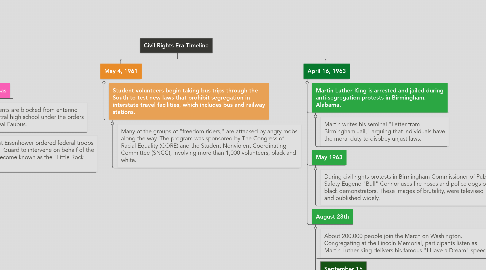
1. May 17, 1954
1.1. Brown vs. Board of Education
1.1.1. Topeka, Kansas
1.1.2. Unanimously agreed that segregation in public schools is unconstitutional
1.2. Overturning the 1896 Plessy vs. Ferguson case that promoted "separate but equal" segregation of races.
1.2.1. The Supreme Court ruled that separate educational vicinities are unequal.
1.2.2. Thurgood Marshall then became the nation's first black justice to serve in the Supreme Court.
2. August/December 1, 1955
2.1. At just 14 years old Emmett Till is visiting relatives in Mississippi when he is kidnapped, beaten, and shot with his unresponsive body left in the Tallahatchie River for allegedly whistling at a white woman.
2.1.1. Rosa Parks is arrested for refusing to give up her seat in the front of the colored section of a bus to a white man.
2.1.2. Montgomery black community is then forced to start a bus boycott led by Reverend Martin Luther King Jr., that prolonged until December 21, 1956 when public buses are desegregated.
3. September 1957
3.1. Little Rock, Arkansas
3.1.1. Nine black students are blocked from entering an all-white Central high school under the orders of Governor Orval Faubus.
3.1.2. President Dwight Eisenhower ordered federal troops and the National Guard to intervene on behalf of the students, who become known as the "Little Rock Nine."
4. May 4, 1961
4.1. Student volunteers begin taking bus trips through the South to test new laws that prohibit segregation in interstate travel facilities, which includes bus and railway stations.
4.1.1. Many of the groups of "freedom riders," are attacked by angry mobs along the way. The program was sponsored by The Congress of Racial Equality (CORE) and the Student Nonviolent Coordinating Committee (SNCC), involving more than 1,000 volunteers, black and white.
5. April 16, 1963
5.1. Martin Luther King is arrested and jailed during anti-segregation protests in Birmingham, Alabama.
5.1.1. Martin writes his seminal "Letter from Birmingham Jail," arguing that individuals have the moral duty to disobey unjust laws.
5.2. May 1963
5.2.1. During civil rights protests in Birmingham Commissioner of Public Safety Eugene "Bull" Connor uses fire hoses and police dogs on black demonstrators. These images of brutality, were televised and published widely.
5.3. August 28th
5.3.1. About 200,000 people join the March on Washington. Congregating at the Lincoln Memorial, participants listen as Martin Luther King delivers his famous "I Have a Dream" speech.
5.3.2. September 15
5.3.3. Four young girls: Denise McNair, Cynthia Wesley, Carole Robertson, and Addie Mae Collins are attending Sunday school when they are killed by a bomb that explodes at the Sixteenth Street Baptist Church, a popular location for civil rights meetings.
6. July 2, 1964
6.1. President Johnson signs the Civil Rights Act of 1964. The most erupting civil rights legislation since Reconstruction. The Civil Rights Act prohibits discrimination of all kinds based on race, color, religion, or national origin.
6.1.1. Employee
6.1.2. Employee
6.2. August 4th
6.2.1. In Neshoba Country, Mississippi the bodies of three civil-rights workers: two white, one black, are found in an earthen dam.
6.3. June 21st
6.3.1. James E. Chaney, Andrew Goodman, and Michael Schwerner, had been working to register black voters in Mississippi, and, on June 21, had gone to investigate the burning of a black church.
6.3.2. They were arrested by the police on speeding charges, incarcerated for several hours, and then released after dark into the hands of the Ku Klux Klan, who murdered them.
7. February 21, 1965
7.1. Harlem, New York. Malcolm X, black nationalist and founder of the Organization of Afro-American Unity, is shot to death. It is believed the assailants are members of the Black Muslim faith, which Malcolm had recently abandoned in favor of orthodox Islam
7.1.1. April 4th 1968
7.1.1.1. Memphis, Tennessee. Martin Luther King, at age 39, is shot while standing on the balcony outside his hotel room. Escaped convict and committed racist James Earl Ray is convicted of the crime. (Memphis, Tenn.) Martin Luther King, at age 39, is shot as he stands on the balcony outside his hotel room. Escaped convict and convicted rapist James Earl Ray is convicted of the crime.
7.1.1.2. April 11th
7.1.1.3. President Johnson signs the Civil Rights Act of 1968, prohibiting discrimination in the sale, rental, and financing of housing.

